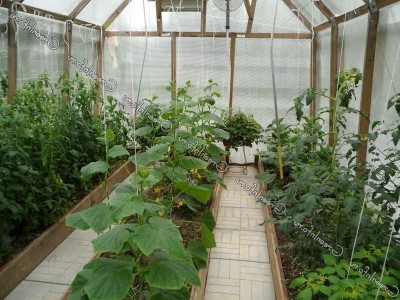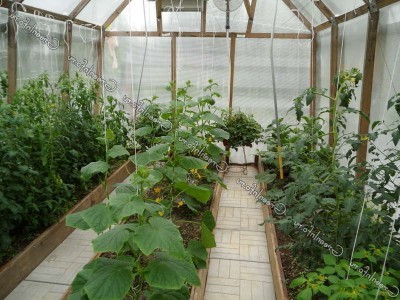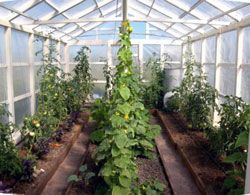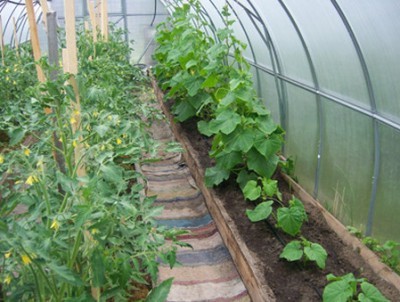Content:
- Scheme of planting vegetables in a greenhouse.
- Growing tomatoes in a greenhouse video.
- Growing cucumbers in a greenhouse video.
- Crop rotation in a greenhouse.
Growing vegetables in a greenhouse may seem simple and easy. After all, the beds are under a roof and therefore are not afraid of either acid rain or wind, always warm. This is all true, but there are some inconveniences. This includes a lack of space, pests that feel very comfortable in greenhouses, and problems with ventilation.It is easier to heat a greenhouse in cold weather than to ventilate it in hot weather. The larger the area, the more difficult it is to ventilate it. To successfully grow vegetables in a greenhouse, you must know and take into account all these features.
To make the greenhouse more evenly illuminated, it is installed from north to south (along its length). In this case, the eastern part will be illuminated by the morning sun, the western part by the evening sun, and the afternoon sun will be more gentle on the plants.
Scheme of planting vegetables in a greenhouse
How to place vegetables in a greenhouse. Experts never recommend growing tomatoes and cucumbers in the same greenhouse, since crops require different microclimates for successful growth and fruiting. Tomatoes love dry air, while cucumbers need high humidity to grow well.
But for most summer residents, building even two greenhouses on a plot is not an affordable luxury: there are not enough acres, and it is financially expensive. Therefore, in one greenhouse, summer residents often grow not only cucumbers and tomatoes, but also other vegetables.
Growing vegetables in a greenhouse. Growing peppers, video.
When undertaking to grow different vegetables in the same greenhouse, it is important to place them correctly so that they do not interfere with each other, while receiving enough light and being well ventilated.
For the entire length of the greenhouse, you can make three beds sixty centimeters wide (60 × 3 = 180 cm), leaving two
a passage 60 cm wide to make it convenient to care for plants (60 × 2 = 120 cm). This way we will master the entire width of the greenhouse (180+120=300 cm). We will plan the central bed for growing cucumbers, building a trellis for them.
The simplest option: a plastic net for climbing plants (sold in country stores), stretched between several stakes dug in about 1.25 m from each other. We connect them on top with strips or strong wire. We stretch the mesh over the resulting frame.
In the southern part of the beds we leave space for growing the most heat-loving crops - peppers and eggplants. In the northern part, you can sow greens in one row: dill, parsley, celery. Dill will quickly go away, and parsley and celery will continue to supply aromatic herbs to the table in November.
We will plant tomatoes closer to the walls (on both sides of the cucumbers). And so that they do not shade the cucumbers, it is better to opt not for tall cucumbers, which are most often grown in greenhouses, but for determinate varieties and hybrids that can be grown without a trellis (it is enough to tie each bush to a stake). If you plant varieties of different ripening periods or seedlings of different ages, the harvest can be obtained until late autumn.
Growing eggplants indoors.
With this scheme for planting vegetables in a greenhouse (cucumbers on a trellis in the center, tomato bushes tied to stakes on both sides of them), there will be enough light for all plants, and they will be ventilated quite well if the seedlings are not planted too densely and the plants Shape cucumbers as they grow.
Before planting the main crops in early spring, lettuce, spinach, Chinese cabbage, radishes are sown in greenhouses, shallots are planted, the bulbs of which very quickly produce high-quality greens. But this recommendation is for next season.
In greenhouses made of cellular polycarbonate, plants are protected from ultraviolet radiation; the sun's rays do not “hit” one point, but are scattered, so the leaves of plants in such a greenhouse do not get burned.So growing vegetables in a polycarbonate greenhouse is more preferable than in a glass one.
And yet you will have to take care of the microclimate all the time. If in spring and autumn it is important to “retain” heat, then in summer you need to protect plants from overheating by constantly ventilating the greenhouse. Mulching the beds with humus and compost will protect the plant from excessive moisture. At normal humidity, condensation does not form on the walls of the greenhouse.
Growing tomatoes in a greenhouse, video
Preparing the soil for growing tomatoes in a greenhouse. If the soil in the area is heavy, when digging, add a bucket of good humus or compost and half a bucket of coarse sand for each square meter. We will also improve the sandy soil with organic matter. It would be nice to add turf soil to it. Add two tablespoons of superphosphate, a tablespoon of potassium sulfate and a teaspoon of urea per square meter. m. Planting holes can be shed with phytosporin-M or extrasol, other biologically active preparations.
Growing tomatoes in a greenhouse. Planting tomato seedlings, video.
Planting tomato seedlings. We plant tomato seedlings 50 cm apart. We try to place the stems of the seedlings vertically. If there is a need to bury the seedlings (they have outgrown them), we do not do this right away. Having dug a deep hole and planted the seedlings in it, first we fill in only the root ball, and after two weeks, when the seedlings have taken root, we add soil into the hole, stimulating the formation of additional roots on the stems.
Caring for tomatoes in a greenhouse. We water the planted seedlings, then mulch the surface of the soil with dry soil or compost. Post-planting watering will last the plants for at least a week.Watering tomato seedlings after planting every day is not necessary and even harmful.
And in the future, you need to take into account that in a greenhouse the soil remains moist longer than in open ground, so we water less often. Overmoistening is fraught with diseases, a decrease in the quality of fruits (they grow sour, watery), and the yield will be low. Water the tomatoes with warm water. Approximately two weeks after planting, we tie up the strong seedlings.
Formation of tomato bushes, video.
During the flowering period, for better pollination on tomato bushes, shake the flower brushes. To do this, just lightly tap on the stakes to which the bushes are attached. Better fruit set is achieved if you treat the tomato bushes with “Ovary” during the flowering period of the first and subsequent clusters.
During the flowering period of tomatoes, be sure to ventilate the greenhouse: too humid air and high temperatures do not contribute to good fruit set.
How to feed tomatoes. When growing tomatoes in a greenhouse, they must be grown at least three times need to be fed.
First feeding - during the budding period: 0.5 liters of infusion of bird droppings or mullein and superphosphate extract, prepared from 1-1.5 tablespoons of fertilizer, per 10 liters of water. You can select modern complex fertilizers for tomatoes, which are produced taking into account the crop’s nutritional needs by development phase.
Feeding tomatoes, video.
Second feeding — during the period of active flowering of the second cluster: a tablespoon of complex fertilizer per 10 liters of water.
Third feeding — at the beginning of the third cluster blooming: a tablespoon of complex fertilizer per 10 liters of water. When feeding for the first time, a liter of nutrient solution is enough for one plant. More mature plants should receive 1.5-2 liters.But don’t overdo it: it’s better to underfeed than to overfeed.
If, after all, the tomatoes have become fattened (powerful bushes do not bear fruit well), they should be reoriented to fruiting: make an extract of superphosphate at the rate of 3 tbsp. spoons per 10 liters of water and pour over the tomatoes (liter of solution per plant).
In order for growing tomatoes in a greenhouse to be productive, you need to carefully monitor the temperature throughout the season. When the air temperature in the greenhouse is above +30°, the pollen is sterilized and fruit set does not occur.
Growing cucumbers in a greenhouse, video
Planting cucumbers. Cucumber seedlings for the greenhouse are most often also grown at home - in cassettes or cups, so as not to injure the roots during transplantation. It turns out to be a double race in time: by sowing cucumbers on the windowsill in late March-early April and planting them in the soil of the greenhouse in the second ten days of April, we will get cucumbers a month earlier than in open ground.
Planting cucumbers in a greenhouse, video.
But if we are late with sowing on the windowsill, we will sow the cucumbers directly into the greenhouse. We will water the seeding furrows with warm water, after planting we will mulch the soil surface and additionally cover it with a film, under which a warmer microclimate will be created for the seeds, and they will sprout faster.
If even after the emergence of seedlings it will be cool in the greenhouse (below +15 degrees), we will not remove the film, but only lift it above the bed, throwing it over the wire arches. The optimal temperature for growing cucumbers in a greenhouse is plus 18-25 degrees.
How to feed cucumbers. Cucumbers love organic fertilizers, Therefore, we bring them into the garden bed for digging and later constantly update the mulch layer by adding compost or humus.But we apply mineral fertilizers with caution: cucumbers do not like high concentrations of salts. We feed them every 7-10 days, adding a teaspoon of fertilizer per 10 liters of water.
How to feed cucumbers, video.
In the first feeding it can be urea to activate the growth of the vegetative mass; in subsequent feedings we add potassium sulfate and superphosphate extract. Mineral fertilizers can be alternated with organic ones: 0.5 liters of mullein or green grass infusion per 10 liters of water.
How to shape cucumbers in a greenhouse. When growing cucumbers in a greenhouse, the plants must be shaped and tied to a trellis. If a plastic mesh is chosen as a trellis, it is enough to direct the main stem of the cucumbers vertically upward along it. The optimal height of the trellis is 2 meters. High altitude will complicate the care of cucumbers and create shading for neighboring plants.
When the cucumber plants form 7-8 true leaves, we begin shaping. Once a week we twist the main stem around the twine or net clockwise, leaving the top hanging freely.
On the lower part of the main stem (to approximately a height of 20 cm), we remove all side shoots and ovaries. We do this in order to improve ventilation and speed up the fruiting of the main shoot.
At a height of up to 80-90 cm on the main stem, we shorten the side shoots by 1-2 leaves, leaving one ovary at a time. At a height of up to 1.3 m, we pinch off the side shoots, leaving two leaves and two ovaries. At the top of the stem we pinch the side shoots into three leaves and three ovaries.
We wrap a shoot that has grown to the top of the trellis around the horizontal part of the trellis, leave 1-2 ovaries, 3-4 leaves and pinch. We direct two side shoots that begin to grow in different directions: one to the right, the other to the left.
Formation of cucumbers in a greenhouse, video
If you don't have the time and desire shape cucumbers, plant them sparser and, removing the side shoots only in the lower part, give the rest free rein. Modern hybrids bear fruit on both the main and lateral stems. But you still have to direct the shoots upward along the grid.
It must be said that growing cucumbers in a greenhouse is somewhat simpler than growing tomatoes.
Crop rotation in a greenhouse
After the end of the season, we will take care of the soil in the greenhouse. Replacing the top layer with a fresh one is problematic, so you will have to make do with half measures: sow green manure, let them grow and dig up.
In a greenhouse, as in open ground, a change of crops is required. Anyone who grows vegetables in a greenhouse knows how difficult it is to organize such a shift. And in this case, green manure can provide invaluable help in the greenhouse.
After removing the remnants of the crop from the greenhouse, rye is immediately sown there. Naturally, under the roof it will be able to increase its green mass longer, and in the spring it will resume growth earlier than in open beds. Naturally, it can be embedded in the soil earlier than in open ground or simply mowed so that in two weeks you can plant seedlings of tomatoes or cucumbers.
Next season, after harvesting, sow mustard green manure. It also disinfects the soil well. The third green manure can be legumes or phacelia. This is how you will get crop rotation in your greenhouse, but not the main crop, but green manure. Each green manure crop will make its contribution to improving the structure, improving the health of the soil, and enriching it with nutrients.
Of course, in the process of growing vegetables in a greenhouse, many questions may arise regarding protecting plants from diseases and pests, fertilizing, shaping, etc.But still, the main thing for plants is a favorable microclimate, balanced nutrition, and timely watering. Having managed to please the vegetables, you will have vitamins on your table until late autumn.
You might be interested in:
- Warm bed for growing cucumbers
- Technology for growing cucumbers in greenhouses
- How to grow tomatoes correctly





 CUCUMBERS NEVER GET SICK, I'VE BEEN USING ONLY THIS FOR 40 YEARS! I SHARE A SECRET WITH YOU, CUCUMBERS ARE LIKE THE PICTURE!
CUCUMBERS NEVER GET SICK, I'VE BEEN USING ONLY THIS FOR 40 YEARS! I SHARE A SECRET WITH YOU, CUCUMBERS ARE LIKE THE PICTURE! You can dig a bucket of potatoes from each bush. Do you think these are fairy tales? Watch the video
You can dig a bucket of potatoes from each bush. Do you think these are fairy tales? Watch the video
 How our fellow gardeners work in Korea. There is a lot to learn and just fun to watch.
How our fellow gardeners work in Korea. There is a lot to learn and just fun to watch. Eye trainer. The author claims that with daily viewing, vision is restored. They don't charge money for views.
Eye trainer. The author claims that with daily viewing, vision is restored. They don't charge money for views. A 3-ingredient cake recipe in 30 minutes is better than Napoleon. Simple and very tasty.
A 3-ingredient cake recipe in 30 minutes is better than Napoleon. Simple and very tasty. Therapeutic exercises for cervical osteochondrosis. A complete set of exercises.
Therapeutic exercises for cervical osteochondrosis. A complete set of exercises. Which indoor plants match your zodiac sign?
Which indoor plants match your zodiac sign? What about them? Excursion to German dachas.
What about them? Excursion to German dachas.
Growing cucumbers in greenhouses in the video is slightly different from growing them in open ground. Seedlings, as well as seeds, are planted in the greenhouse much earlier, most often this happens in early May.
If tomatoes were grown in a greenhouse in winter, and the first fruits have already appeared in the spring, then they should be harvested every 2-3 days until summer. But from summer to autumn - every day.